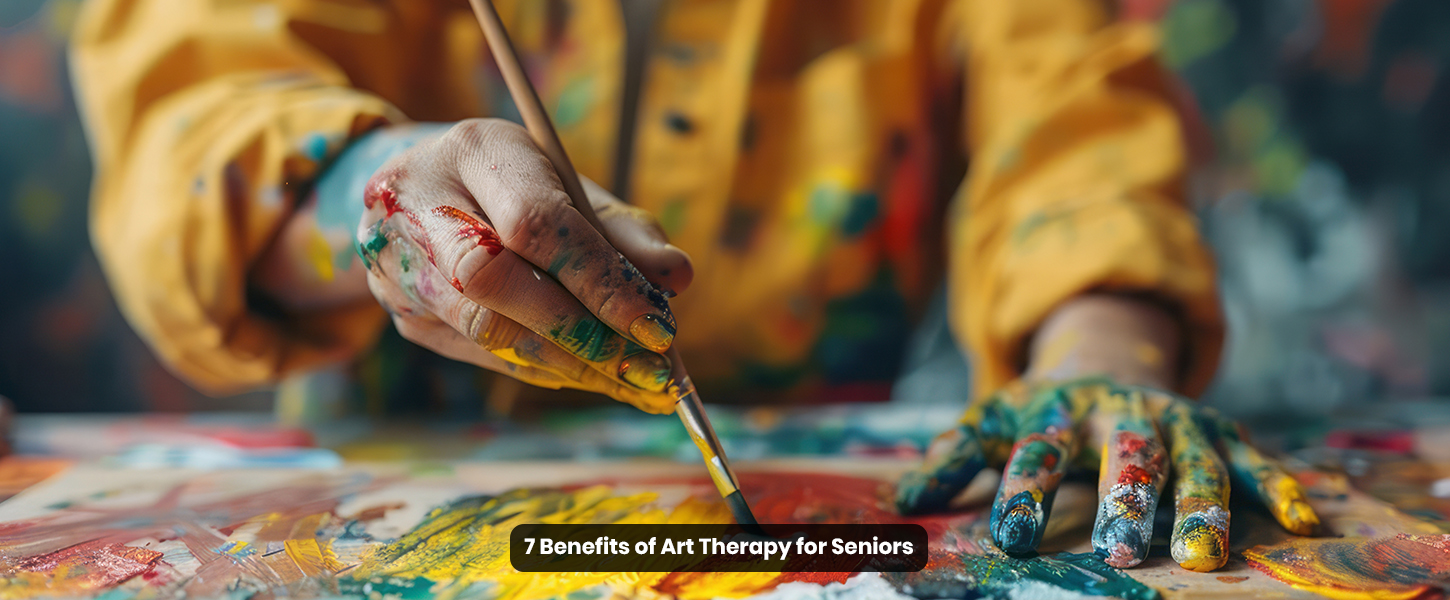Exploring Art Therapy 7 Benefits For Senior Well Being
Art therapy serves as a vibrant exercise for the mind. For seniors, engaging in creative tasks not only ignites the imagination but also acts as a potent stimulus for cognitive functions. The process of selecting colors, planning a composition, or even sculpting involves complex decision-making, problem-solving, and memory recall. These activities are known to stimulate neural pathways and encourage neuroplasticity, which is vital for maintaining cognitive health.
Studies have indicated that when seniors participate in art therapy, they often enter a state of focused concentration—commonly referred to as the “flow state.” In this state, the brain is deeply engaged, promoting the development of new connections and reinforcing existing ones. This cognitive engagement can contribute to slowing the natural decline in mental acuity that often accompanies aging. For example, when an older adult paints or draws, they not only express their inner emotions but also challenge themselves to observe, interpret, and recreate visual information. This act of observation coupled with creative decision-making exercises the brain much like a physical workout conditions muscles.
Moreover, art therapy encourages the exploration of different sensory experiences. The tactile sensation of clay, the visual impact of color contrasts, and even the rhythmic motion of brushstrokes contribute to sensory integration. This multi-sensory stimulation is especially beneficial for seniors who might be facing sensory deficits, as it provides a gentle yet effective method to keep the brain actively processing diverse stimuli. In addition, regularly engaging in these artistic pursuits can help maintain concentration and focus, which are often compromised by age-related cognitive changes. By reinforcing neural networks, art therapy has the potential to enhance memory retention and improve problem-solving skills.
The creative process also invites an element of novelty—trying new techniques or experimenting with unfamiliar mediums stimulates curiosity and motivates lifelong learning. As seniors experiment with different forms of art, they challenge themselves to think outside their habitual patterns, which not only prevents cognitive stagnation but also promotes adaptive thinking. The gradual progression from simple sketches to more elaborate projects mirrors the incremental growth of cognitive resilience. Ultimately, this cognitive stimulation through art contributes to a sharper, more agile mind, ready to meet the challenges of aging with renewed vitality.
Emotional Expression and Regulation
Emotions can be complex and, at times, difficult to articulate—especially for seniors who have lived through a multitude of life changes and experiences. Art therapy offers a unique avenue for emotional expression, providing a non-verbal language through which feelings can be communicated. Rather than relying solely on words, seniors can use colors, textures, and forms to represent their inner states, making the intangible tangible.
The process of creating art allows older adults to externalize emotions that might otherwise remain bottled up. For those who find it challenging to discuss their feelings openly—whether due to cultural norms or personal reservations—art becomes a silent yet powerful medium of self-expression. Through painting, drawing, or sculpting, individuals can translate experiences of joy, sorrow, or anxiety into a visual form that can be observed, processed, and understood. This process of externalization can lead to improved emotional regulation as it enables a more objective reflection on one’s internal state.
Moreover, art therapy provides a safe space for exploring difficult emotions without the fear of judgment. Seniors may find that as they depict their feelings on canvas or through other mediums, they gradually gain insights into their emotional patterns. This awareness is the first step toward effective emotional regulation. By understanding and accepting their emotions, individuals can begin to process grief, anxiety, or loneliness in a constructive manner. The creative journey often leads to a sense of catharsis—a release of pent-up emotions that results in a feeling of relief and inner peace.
Additionally, the reflective nature of art-making can foster self-compassion. When seniors see their emotions represented in their artwork, it can validate their experiences, reminding them that every emotion has a rightful place in the tapestry of life. Over time, this recognition can build resilience, enabling seniors to better manage stress and emotional turbulence. In essence, art therapy transforms the raw intensity of emotions into a form that can be understood, navigated, and ultimately, healed.
Stress Reduction and Relaxation
Art-making can act as a natural antidote to the stresses of daily life. Seniors, who may face challenges such as declining physical health, loneliness, or the loss of loved ones, can find solace in the creative process. Engaging in art allows them to step away from the pressures of everyday life and immerse themselves in an activity that encourages mindfulness and relaxation.
One of the key benefits of art therapy is its ability to induce a state of deep relaxation—often referred to as the “flow state.” In this state, individuals become so absorbed in their creative work that external worries fade into the background. This deep immersion helps to reduce stress levels and can even lower physiological markers of stress, such as blood pressure and cortisol levels. The repetitive nature of certain art activities—such as brushstrokes, the smooth motion of sculpting, or the rhythmic cutting of paper—can also have a meditative effect. These repetitive actions not only distract from stress but also promote a calming routine that the body and mind come to expect as a period of relaxation.
Furthermore, the creative process offers a distraction from the negative thoughts that often contribute to anxiety. When seniors focus on transforming a blank canvas into a work of art, they are channeling their energy into something productive and positive. This redirection of focus can interrupt cycles of rumination and provide mental relief. Over time, this regular practice of mindfulness through art-making can cultivate a more relaxed approach to life, allowing seniors to handle stressors with greater resilience and calm.
The therapeutic benefits extend beyond mere distraction. By integrating art into their routine, seniors build a regular habit of engaging in an activity that brings joy and satisfaction. This, in turn, can lead to a more optimistic outlook on life, reducing the impact of stress. The physical act of creating art—whether it is the gentle movement of the hands or the steady application of color—also contributes to a sense of bodily well-being, reinforcing the connection between mind and body in the healing process. In this way, art therapy serves as both a mental and physical refuge, offering seniors a practical tool to manage the stresses inherent in the aging process.
Enhanced Self-Esteem and Sense of Purpose
A major challenge that many seniors face is the erosion of self-esteem, often as a result of retirement, loss of social roles, or the physical limitations imposed by aging. Art therapy offers a constructive means to rebuild and reinforce self-worth. Through the act of creation, seniors are reminded of their inherent capabilities and the value of their personal experiences.
When seniors complete an art project, the tangible result is a visible representation of their talent and effort. This accomplishment can significantly boost self-esteem. Unlike other activities that might emphasize productivity in a conventional sense, art provides a personal and subjective measure of success. The focus is not on perfection but on expression and progress. Every brushstroke, every shape, and every color choice represents a personal journey, reinforcing the idea that one’s creativity and uniqueness are assets at any age.
Moreover, the process of creating art often instills a renewed sense of purpose. For many older adults, the transition from a career-driven identity to retirement can lead to a loss of direction. Art therapy helps fill this void by offering an activity that is both engaging and meaningful. Whether it’s through participating in community art classes or simply exploring art in a private setting, seniors can rediscover a passion that transcends the challenges of aging. This renewed engagement with life can lead to a more optimistic outlook, where individuals begin to see themselves not as diminished by time but as ever-evolving beings with continuous potential.
The sense of purpose that comes from art-making is also enhanced by the opportunity for self-reflection. As seniors delve into their artistic process, they often uncover hidden emotions, memories, and desires that contribute to a deeper understanding of self. This journey of self-discovery can empower them to embrace their life experiences, turning perceived losses into sources of wisdom and strength. Over time, these experiences foster a positive self-image and a reinforced sense of dignity, allowing seniors to navigate the complexities of aging with confidence and grace.
Social Engagement and Connection
Isolation and loneliness are significant issues in senior communities, yet social connections play a critical role in overall health and happiness. Art therapy offers an inviting platform for social engagement by bringing people together over a shared creative interest. Group art therapy sessions create a supportive community where seniors can interact, collaborate, and share their personal stories through artistic expression.
Participating in group projects encourages seniors to communicate and connect. When individuals share their artwork, they also share parts of themselves, fostering empathy and mutual understanding. This communal environment breaks down social barriers and can lead to lasting friendships. In many cases, these interactions extend beyond the creative space, helping seniors build a broader support network that can provide both emotional and practical assistance.
The collaborative nature of art therapy sessions also cultivates a sense of belonging. For seniors who may feel marginalized or isolated due to the loss of traditional social roles, engaging in art becomes a way to re-establish their identity as creative contributors. The act of working together—discussing techniques, offering feedback, or simply admiring each other’s work—creates an atmosphere of mutual respect and encouragement. Such environments can counteract the feelings of loneliness and disconnection that are often experienced in later life.
Additionally, art therapy sessions sometimes include public exhibitions or community events, which allow seniors to present their work to a wider audience. This public recognition further validates their creative efforts and can reinvigorate their sense of social importance. The shared celebrations of artistic achievements remind seniors that their voices and experiences matter, reinforcing their role in the community. Overall, by fostering opportunities for interpersonal interaction and collaboration, art therapy not only nurtures creative expression but also builds a vital social fabric that enhances overall well-being.
Physical Benefits
While art therapy is often celebrated for its mental and emotional benefits, it also offers surprising physical advantages for seniors. Engaging in creative activities can contribute to improved fine motor skills and enhanced hand-eye coordination. Whether it is through the careful manipulation of a paintbrush, the deliberate shaping of clay, or the precise application of craft materials, seniors find that art challenges the body as well as the mind.
For many older adults, maintaining dexterity is a crucial aspect of daily life. Regular participation in art activities helps keep the muscles and joints active, preventing stiffness and promoting flexibility. The repetitive motions involved in painting or drawing provide a form of gentle exercise that can improve muscle tone and joint mobility. In some cases, art therapy is incorporated into rehabilitation programs as a means of supporting physical recovery while simultaneously boosting morale.
Moreover, the physical act of creating art has been shown to have positive effects on overall motor control. As seniors focus on the precise movements required for their artistic pursuits, they inadvertently engage in exercises that enhance coordination. This improvement in coordination can translate to other daily activities, reducing the risk of falls and increasing overall physical independence. Even for those with limited mobility, adaptive art activities can be tailored to accommodate various physical abilities, ensuring that everyone can enjoy the benefits of creative expression.
The connection between art and physical health is further underscored by the holistic nature of therapy. As seniors experience improved physical coordination and dexterity, they also develop a stronger connection between mind and body. This integrated approach to well-being emphasizes that health is multidimensional—encompassing the physical, mental, and emotional aspects of life. By participating in art therapy, seniors can enjoy a gentle yet effective way to maintain physical fitness, all while engaging in a fulfilling and creative pursuit.
Memory is a cornerstone of personal identity, and for seniors, the preservation of memories is paramount. Art therapy has been shown to be particularly effective in enhancing memory recall and preservation. Through creative expression, individuals can explore personal histories and bring their most cherished memories to life on canvas or paper.
When seniors create art that reflects their life experiences, they engage in a process of reminiscence that can spark detailed recollections of past events, relationships, and personal milestones. This creative recall is not only emotionally rewarding but also serves a therapeutic function by reinforcing a sense of identity. For individuals experiencing memory loss or conditions such as dementia, art therapy provides an alternative means of communication. Even when verbal expression becomes challenging, artistic expression offers a way to convey personal narratives and maintain continuity of self.
Furthermore, art therapy can serve as a bridge between past and present. By revisiting old memories and incorporating them into new works of art, seniors are able to contextualize their experiences within a broader life story. This process can help them understand and accept the passage of time while cherishing the moments that define their journey. The act of creating a visual diary not only preserves these memories but also transforms them into a legacy that can be shared with family and friends.
The therapeutic benefits extend to cognitive functions as well. The mental exercise involved in recalling and organizing memories in a creative format stimulates brain regions responsible for memory and learning. Over time, this can help in slowing the progression of memory-related conditions and in enhancing overall cognitive resilience. Ultimately, art therapy empowers seniors to hold onto their personal histories, ensuring that their memories remain an active and celebrated part of their identity.
In conclusion, art therapy is much more than an aesthetic pursuit—it is a multifaceted tool that enriches the lives of seniors on cognitive, emotional, social, physical, and memory levels. By engaging in creative expression, older adults can experience enhanced cognitive stimulation, more effective emotional regulation, deep relaxation, renewed self-esteem, enriched social connections, improved motor skills, and stronger memory recall. These seven benefits collectively offer a robust framework for improving senior well-being, making art therapy an invaluable addition to holistic care programs.
As our society continues to recognize the unique challenges of aging, innovative approaches like art therapy not only provide an outlet for creative expression but also offer a pathway to a more fulfilling and connected life. Seniors who embrace art therapy discover that creativity does not diminish with age—it evolves. Their art becomes a celebration of life’s journey, a testament to the enduring human spirit, and a reminder that self-expression and healing are available at every stage of life.
In this ever-changing world, where the pace of life can often be overwhelming, art therapy stands as a beacon of hope and resilience. It bridges the gap between the inner world and external reality, providing seniors with the tools to navigate the complexities of aging with dignity, creativity, and grace. Whether through solitary reflection or group collaboration, the act of creating art is a celebration of life—a reminder that every brushstroke, every color, and every form is an affirmation of one’s enduring potential.
News -
Watch Domelipa Viral Video Tiktok Star Leak New Scandal
Watch Video Yailin La Mas Viral Full Video On Twitter
Watch Chikafornai Video Helado Lachlan Video Telegram _Valeeesitaaaaa999
Watch Gabriela Lima Santana Video Twitter Watch
Marurista Viral Video Exploring the Phenomenon Behind the Sensation
Watch Video Girl Flashes On Jack Doherty Leak Live Stream In Public
Watch Video Teguh Suwandi X Msbreewc Viral 7 Menit Tiktok




